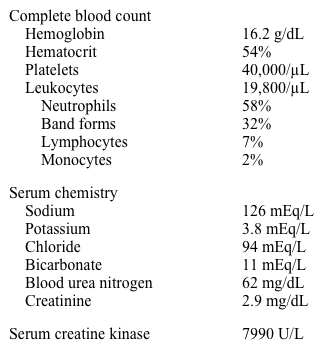A 28-year-old woman with fever and lethargy is brought to the emergency department accompanied by her roommate. The roommate reports that the patient appeared well last night but awoke this morning confused. Throughout the morning she became increasingly confused and eventually unarousable, prompting her roommate to call an ambulance. Her past medical history is significant for idiopathic thrombocytopenia purpura. There is no history of recent travel.
Her temperature is 39.4 C (103 F) , blood pressure is 84/42 mm Hg, pulse is 122/min, and respirations are 28/min. Oxygen saturation is 90% on room air. Physical examination shows an ill-appearing woman. Pupils are equal and round but sluggish. Lungs have patchy rales. Abdominal examination reveals a surgical scar in the left upper quadrant. There are diffuse ecchymotic areas throughout the torso and lower extremities, with areas of bullae and vesicle formation. There is no rash on the palms or soles. There are no meningeal signs.
Laboratory results as follows:
Chest x-ray reveals bilateral pulmonary infiltrates.
Which of the following antibiotics would be most effective at targeting the suspected pathogen?
Definitions:
Q3: A 76-year-old man is seen in the
Q3: A 22-year-old-woman comes to the office with
Q12: Solve the equation. Write all solutions and
Q14: The acronym used to refer to the
Q19: If it is clear that the rule
Q20: The closing of legal correspondence usually includes
Q21: A 65-year-old man comes to the clinic
Q50: A 40-year-old man is brought to the
Q109: A 25-year-old woman being treated for infective
Q126: An 82-year-old farmer comes to the office